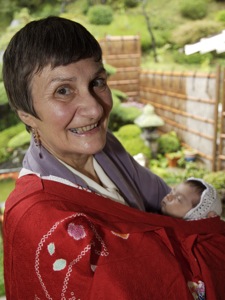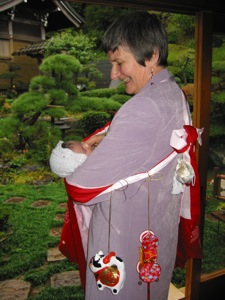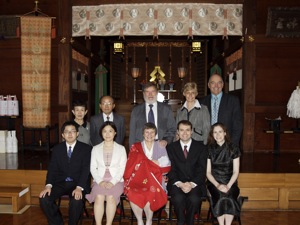
October 31st 2007
The existence of my blog has meant that I've been writing a lot less in the diary section than previously. However, sometimes I have something with pictures, like now. If you're just reading through the diary, without looking at the blog, you will have missed the fact that my wife gave birth to our daughter a few weeks ago. Her family are scattered across the world, with grandparents on three different continents, and so chances for family gatherings are few and far between. However, we have just had one, with everyone coming to Japan for her Hatsu-miya-mairi.
Hatsu-miya-mairi is the Shinto equivalent of Christening. The word means "first visit to the shrine", which is true from the baby's point of view. The formal purpose is to introduce the baby to the kami, and to ask for the kami's protection and assistance in ensuring that she grows up healthy. The fundamental purpose, of course, is to celebrate the birth of a new member of the family, and the community. Traditionally, in most areas, it was held about thirty days after birth; the precise number of days varied by region, and in most places by the sex of the baby, with girls doing it one or two days later. However, the precise number of days could be very local, and everything I've read about the contemporary version says that you shouldn't obsess over the precise day. Certainly, the shrine raised no objections when I booked it months in advance, so that my side of the family could make the necessary arrangements to be here.
We did the Hatsumiyamairi at our local shrine, Shirahata Hachiman Daijin (or Shirahata Yahata Ohkami, as the characters are read in the prayers). The first step was thus to get everyone together, which we managed. The second step was getting to the shrine. It is easy walking distance from our flat, and so should be no problem. The fact that a typhoon hit Tokyo that day made things a little more tricky. Fortunately, it was only a weak typhoon, so we could still walk, with careful use of umbrellas to keep Mayuki (our daughter) dry. She slept through the walk, so that worked out fine.
When we arrived at the shrine, it looked like another Hatsumiyamairi, or possibly Shichigosan, was happening, so we headed off to the waiting room to get ready. I may have mentioned before that the room is rather nice; it's a tatami mat room, with large windows looking out onto a traditional Japanese garden. One of the bonuses of going on a formal sanpai to Shirahata-san is getting to see the garden. For most of us, getting ready just meant taking our raincoats off. My mother, however, had to do a bit more.
 My mother holding Mayuki, with the kimono wrapped around.
My mother holding Mayuki, with the kimono wrapped around.
At a Hatsumiyamairi, the baby is traditionally carried by her grandmother on her father's side. I am not entirely sure of the origins of this, so the following is partially speculation. The first bit I do know: most local varieties of Shinto are concerned with purity, and blood makes you impure. Since there tends to be a lot of blood involved in childbirth, it makes both the baby and the mother impure. In the baby's case, the period of impurity ended after about thirty days; that is what determined the timing of the Hatsumiyamairi. However, the mother's impurity did not end for rather longer, typically about a hundred days. Thus, the mother could not enter the shrine for the ceremony, so someone else had to carry the baby. Now we enter speculation. In the medieval and early modern periods, young married couples tended to live with the groom's parents, which means that the baby's grandmother on the father's side would have been around and used to the baby. (Obviously, the father couldn't carry the baby, having no idea of what he was doing. I did carry Mayuki to the shrine, however.) Thus, I suspect that the custom that she carried the baby arose partly from practicality, and partly from the desire of grandmothers to carry their grandchildren.
 My mother holding Mayuki, with the good luck objects visible.
My mother holding Mayuki, with the good luck objects visible.
At any rate, that's the tradition, and my mother was able to keep to it, which made her very happy. The grandmother dresses formally, carries the baby, and then wraps a child's celebratory kimono over the top. The kimono is tied around the back to stop it falling off, and particular objects, symbolising a healthy and prosperous future for the child, are tied on; they are visible in the photograph to the right. At the top, under the knot, are a couple of small bags, which represent money bags, and ensure that the baby will always be rich. The next one down is a child's toy, while the one at the bottom is a good-luck cat. I am not sure what the wider significance of these two items is. However, in these ceremonies, the precise items are rarely firmly fixed, with people putting different ones on, as they feel appropriate. Yuriko's former boss lent us the whole set, and it was a very nice kimono, so we very much appreciated that.
Once we were ready, we went through to the shrine building. The basic structure of the ceremony was the same as any formal sanpai. As we entered, the priest beat a taiko to alert the kami to our presence, and we bowed slightly as we entered the shrine. There were two rows of seats set up, with nine seats in each row. Since there were ten of us, that meant we spilled over. Mayuki went in the middle, which meant that my mother did, too. Yuriko and I sat on either side of her. Then we put the rest of my family on my side, and the Yuriko's family on hers. Silver had to sit in the second row, but that did mean she got to sit in the centre. The priest then congratulated us on the birth, and checked a few details before the ceremony started.
As with all sanpai, the ceremony started with purification. The priest knelt in front of the onusa, and said one of the standard purification prayers. Then he took a small bamboo whisk and shook it twice in front of the onusa, I think to purify it before using it purify us. Next, he took the onusa, stood, and went into the back of the shrine, where he shook it to purify the area. Then he came to the front, and we bowed our heads while he shook it over us, to purify us.
The core of the ceremony was the norito, the prayer, which is offered in old Japanese. The priest shook a stick with small bells on as he started, probably to get the kami's attention, and then introduced us; first my and Yuriko's names and address, and then Mayuki's name. The rest of the prayer was for good fortune. I caught the requests for her to grow up healthy, and that she be obedient both to her family and to the gods. I fear that the latter will be a vain hope, if she's like every other child I've ever heard of.
 The group photo inside the shrine, after the ceremony.
The group photo inside the shrine, after the ceremony.
After the norito, we offered tamagushi, which are small branches of sakaki (an evergreen bush used a lot in Shinto ceremonies) with shide (paper strips in lightning shapes) tied to them. This is the point at which the people who are really doing the ceremony get to participate; the priest is, strictly speaking, merely an intermediary. You receive the tamagushi from the priest, then place it on the table, with the base of the branch facing into the shrine. You then bow twice, clap twice, bow once, and return to your place. Yuriko and I offered first, followed by Mum, with Mayuki, and Ray. Then Dad and Joy, and then Yuriko's parents. We all went up in couples. Then Silver and Yuriko's brother Kouji offered branches separately.
I then received the tray of o-sagari, and the priest beat the taiko again to end the ceremony. The o-sagari were standard: a bottle of sake and a pack of katsuo-bushi (dried bonito flakes) symbolising the common meal with the kami, a pack of handkerchiefs as a gift, and a charm and o-fuda. The o-fuda has "Hatsumiyamoude" (an alternative name for the ceremony) and "Mayuki Chart" written on it, and so will be kept. After the ceremony, we also received some nice handmade bookmarks from Hakone, one each, as gifts from the shrine family.
We then spent a lot of time taking photographs, with the result that the next group of Shichigosan people arrived, and I was finally able to confirm something I'd wondered about for a while; the chief priest's wife is also a priest, because she was conducting the ceremony.
In the afternoon we went to Studio Alice, a photography chain that specialises in childrens' photographs, to get some studio photos. That was quite an experience; Studio Alice studios have lots and lots of costumes for children, and because it is Shichigosan season there were a lot of seven, five, and three-year-olds having their pictures done. I've never seen so many small princesses in one place. We also got some nice pictures, and Mayuki was very good. In fact, she was remarkably good all day, even when we went for dinner.
Most of the other things we did were very low key. There was a lot of holding of Mayuki by grandparents and aunts (less by the uncle...), and plenty of time spent as a family. I got to have dinner with my father, and went for a walk with my mother, when we got to see a cloud which diffracted the light of the setting sun into a beautiful display of green, rose, and gold. It was a really good week or so, and the ceremony at the heart of it was particularly nice.